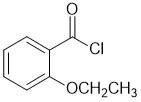Part 8: SPECTROSCOPY
The following data is available from the
question.
Note
: Remember to cross
reference things to confirm.... e.g.
IR may show C=C, use NMR to
confirm that etc.
MS: M+
seen at 184 g/mol, with m, m+2 pattern in 3:1 ratio indicating Cl is present.
IR:
There is a strong C=O just below 1800cm-1 which is high for a simple ketone. No sign of OH or NH. There are absorptions of note either side of 1600 cm-1 which are probably Ar C=C.
13C NMR:
The normal proton decoupled spectrum shows a total of 9 peaks indicating 9 types of
C. By analysis of the chemical shifts, we have the C=O near 165ppm (likely carboxylic acid or derivative) and 6 peaks between 110-160 ppm (ArC) and peaks at 65 and 15 ppm that are
most likely from sp3 C hydrocarbon fragements.
1H NMR:
The proton spectrum shows a total of 6 sets of peaks indicating 6 types of H.
|
d/ppm
|
multiplicity
|
integration
|
Inference
|
|
7.95
|
d
|
1
|
ArH, CH coupled to H |
| 7.35 |
t
|
1
|
ArH, CH coupled to 2H |
|
7.30
|
t
|
1
|
ArH, CH coupled to 2H |
| 7.09 |
d |
1 |
ArH, CH coupled to H |
| 4.13 |
q |
2 |
-CH2 coupled to 3H deshielded |
| 1.42 |
t |
3 |
-CH3 coupled to 2H |
(q = quartet, t = triplet, d = doublet, s = singlet)
The most significant structural information
from this are:
- adding integrals shows 9H (or a multiple thereof)
- it has a disubstituted aromatic (benzene)
- there are coupling patterns to decipher
Summary....
The MS indicated MW = 184 and Cl.
The IR showed the presence of a C=O
13C NMR suggests a disubstituted benzene system with 9 types of C
H NMR gives -CH2-, -CH3, and C6H4 (disubs. benzene)
This information suggests an initial molecular formula = C9H9ClO which gives MW = (9x12) + (9x1) + 35 + 16 = 168 which means we are missing 16.
The missing 16 can be accounted for by another O (H-NMR peak at 3.8ppm suggests a possible -OR group)
Therefore, molecular formula = C9H9ClO2 which has an IHD = 5 consistent with the C=O double bond and benzene.
Altogether...
|
The fragments we have are:

The IR and 13C show a C=O that is a carboxylic acid derivative. The IR C=O frequency of near 1800 cm-1 implies an acyl chloride and rules out an ester or carboxylic acid (no -OH either).
The H-NMR 3H triplet at 1.42 ppm and 2H quartet at 4.13 ppm indicate an ethyl group CH3-CH2-
Given that the methylene --CH2- is at 4.13 ppm then it is an ethoxy group, -O-CH2CH3

This means we are down to just 3 fragments and all that is left to do is establish the regiochemistry of the Ar region since we have a disubstituted benzene with two different substituents. This is most easily done from the NMR. 6 types of ArC and 4 types of ArH, so it must be either ortho- or meta-. Since the aromatic region of the H NMR has 2 x t and 2 x d, then it's ortho- (meta would have an ArH singlet), so giving us the structure... |

o-ethoxylbenzoyl chloride
|
The final step should always be to check what you
have drawn. The easiest thing to check is usually the coupling patterns you
would expect to see, and the chemical shifts of each unit. You should
be asking yourself : "Does my answer give me what the H-NMR shows ?"
Common errors:
MS missed the Cl
IR didn't account for the high C=O frequency (1800 cm-1 is high for a ketone or ester).
H NMR had hydrocarbon pieces that did not fit the integration and coupling patterns (esp. regiochemistry of the disubstituted benzene)
General
- did not check MW with data from MS
- did not check HNMR integration for number of H on the aromatic and hence had incorrect substitution of the benzene.
- did not check HNMR ArH coupling and hence had incorrect regiochemistry of the disubstituted benzene.
![[Home]](../mol.gif)



![[Home]](../mol.gif)